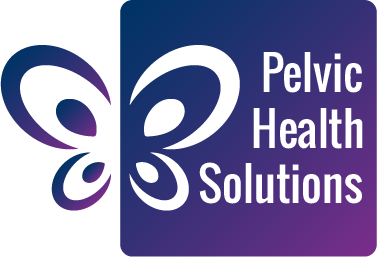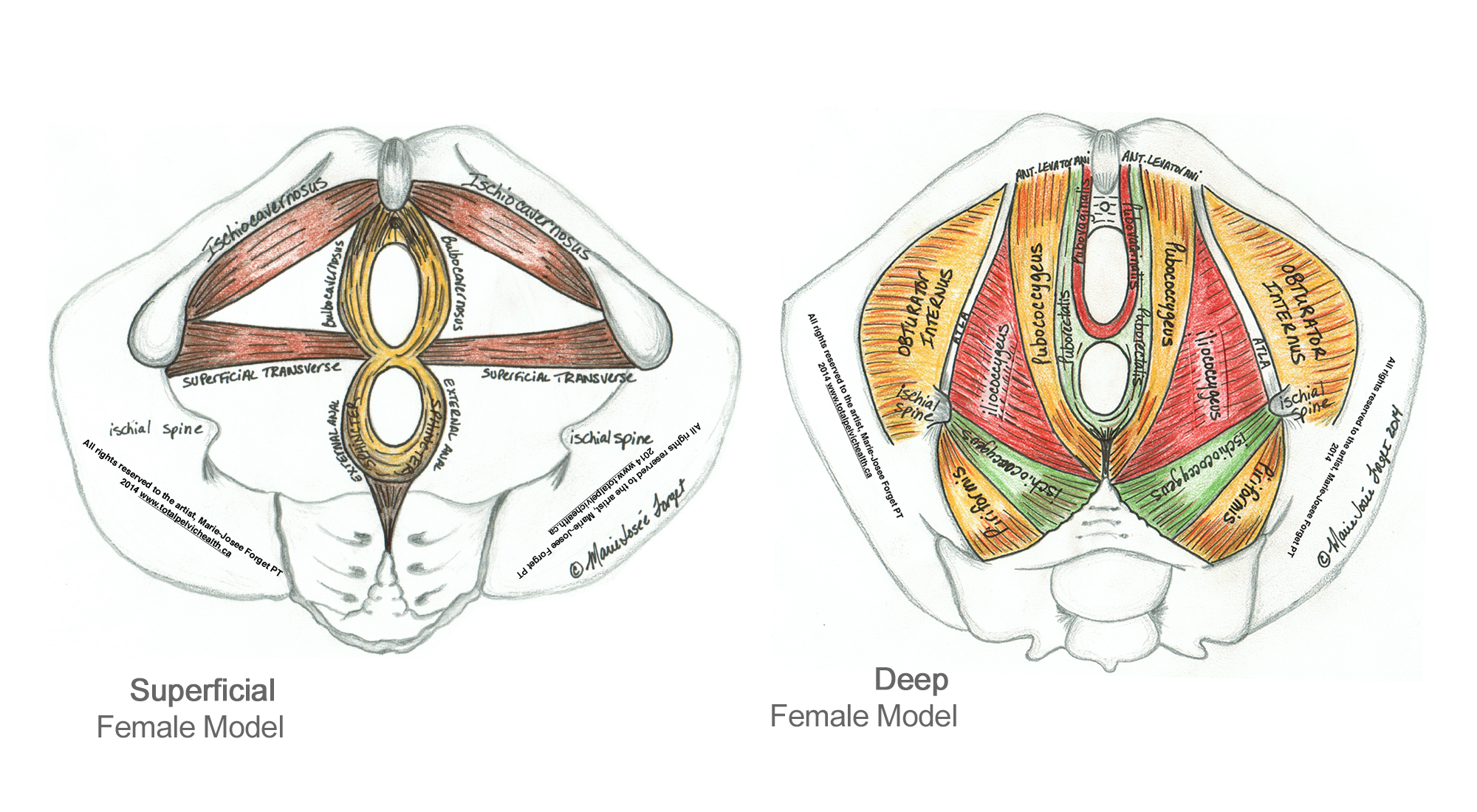Pelvic Floor Muscle Strengthening (Kegels) for Females (Or If You Have a Vulva/Vagina)
Search Knowledge Base by Keyword
Pelvic Floor Muscle Strengthening (Kegels) for Females (Or If You Have a Vulva/Vagina)
The pelvic floor muscles are a group of muscles which extend from the pubic bone in the front to the tailbone in the back, and side to side at the sitz bones (which are the bony structures you feel when you sit). These muscles are like a trampoline and form the bottom of your abdominal container. They are in the shape of a kite, similar to two triangles, back to back. The triangle in the front is called the urogenital triangle, and the back, the rectal triangle. The front triangle has the urethral (where urine exits) and vaginal openings, and the back triangle has the rectal opening.
You can refer to the picture above of the pelvic floor muscles while you are learning how to do these exercises. It may helpful to visualize where these muscles are and how the muscle fibers are oriented.
Key Points on Strengthening Exercises:
- The front and back triangles are connected and will contract together.
- Based on your symptoms, you can focus on one triangle (front triangle for urinary incontinence, back triangle for fecal incontinence).
- Close your eyes as you are visualizing the contraction since these muscles work well under visual guidance.
- To contract the front triangle, imagine that there is a blueberry sitting at the opening of your urethra (where urine exits) and your vagina. Squeeze the blueberry at each opening and draw it inward towards your bellybutton.
- Another cue for the front triangle is imagining you are stopping the flow of urine (never actually stop the flow of urine on the toilet, this can prevent you from completely emptying your bladder).
- You can verify that you are doing this correctly by placing one finger inside your vagina to feel the tightening and lifting inside.
- To contract the back triangle imagine you are stopping the passage of gas or as if you are drawing in a marble into your rectum.
- Other cues you may connect with include drawing your pubic bone and tailbone together and inwards or drawing your two sitz bones together and inwards.
- To start, test how long you can hold the contraction without feeling the muscles let go and add one second to this starting point. Slowly, over the following weeks, you can build up to 10-second holds.
- Hold each area for up to 10 seconds without feeling the muscles let go and repeat up to 30 times, once per day.
- You should rest for 10 seconds in between each contraction.
- Make sure you are not holding your breath or using your buttocks, inner thighs, or abdominal wall.
- Nobody should see any movement while you are doing your pelvic floor contractions.
- Start practicing your pelvic floor contractions in a lying position and progress to different positions (sitting, standing) and during various functional activities (sit-stand, squat, lift) when you feel ready.
- Coordinate your pelvic floor contractions with your breath. Breathe in and relax your pelvic floor, breathe out and contract your pelvic floor.
- It will take daily practice for 3-4 months to see the benefits.
- These muscles take a little bit of concentration, but with some effort, your brain will make a better connection.
Please note: Kegels are NOT always indicated and can sometimes aggravate your symptoms.
When your pelvic floor muscles are tight and weak, the tension is treated before the weakness. Once the muscles have reached a normal resting tone, and are able to relax fully, their strength is reassessed and strengthening exercises may be prescribed.
If your symptoms are not improving, or you think you have tension in your pelvic floor, seek out the help of a Pelvic Health Physiotherapist who has training in internal palpation of the pelvic floor muscles. A customized program (not just Kegels) will be designed for you based on their subjective and objective findings.
-
-
Incontinence: Urinary and Fecal
-
Facts and Myths About Pelvic Floor Dysfunction
-
Pelvic Floor Muscle Weakness
-
Pelvic Floor Muscle Strengthening (Kegels) for Females (Or If You Have a Vulva/Vagina)
-
Pelvic Floor Muscle Strengthening (Kegels) for Males (or if you have a Penis)
-
The Knack
-
Pelvic Floor Muscle Tightness
-
Bladder Irritants
-
-
-
Bowel Dysfunction
-
Pelvic Floor Muscle Weakness
-
Pelvic Floor Muscle Strengthening (Kegels) for Females (Or If You Have a Vulva/Vagina)
-
Pelvic Floor Muscle Strengthening (Kegels) for Males (or if you have a Penis)
-
Pelvic Floor Muscle Tightness
-
Constipation
-
Deep Breathing Exercises
-
Reverse Kegels (Pelvic Floor Drops)
-
-
-
Persistent Pelvic Pain
-
Pelvic Tissue Dysfunction
-
Pelvic Floor Muscle Tightness
-
Deep Breathing Exercises
-
Reverse Kegels (Pelvic Floor Drops)
-
Sensitive Nervous System
-
Types of Pain
-
Understanding Pain Better
-
Laughter
-
Sleep
-
Nutrition and Persistent Pain
-
Connective Tissue Dysfunction
-
What Are My Myofascial Tender Points?
-
Pudendal Nerve Irritation
-
Self-Treatment Techniques for Foam Rolling
-
Pain Education in a Nutshell
-
Catastrophization
-
-
-
Endometriosis
-
Pelvic Tissue Dysfunction
-
Pelvic Floor Muscle Tightness
-
Deep Breathing Exercises
-
Reverse Kegels (Pelvic Floor Drops)
-
Sensitive Nervous System
-
Types of Pain
-
Understanding Pain Better
-
Laughter
-
Sleep
-
Nutrition and Persistent Pain
-
Connective Tissue Dysfunction
-
What Are My Myofascial Tender Points?
-
Self-Treatment Techniques for Foam Rolling
-
Pain Education in a Nutshell
-
Catastrophization
-
-
-
Dysmenorrhea (Painful Periods)
-
Pelvic Tissue Dysfunction
-
Pelvic Floor Muscle Tightness
-
Deep Breathing Exercises
-
Reverse Kegels (Pelvic Floor Drops)
-
Sensitive Nervous System
-
Types of Pain
-
Understanding Pain Better
-
Laughter
-
Sleep
-
Nutrition and Persistent Pain
-
Connective Tissue Dysfunction
-
What Are My Myofascial Tender Points?
-
Self-Treatment Techniques for Foam Rolling
-
Pain Education in a Nutshell
-
Catastrophization
-
-
-
Vaginismus
-
Accommodators and Dilators
-
Pelvic Floor Muscle Tightness
-
Lubricants and Moisturizers
-
Vulvar Care
-
Pelvic Tissue Dysfunction
-
Deep Breathing Exercises
-
Reverse Kegels (Pelvic Floor Drops)
-
Sensitive Nervous System
-
Sleep
-
Types of Pain
-
Understanding Pain Better
-
Laughter
-
Nutrition and Persistent Pain
-
Connective Tissue Dysfunction
-
What Are My Myofascial Tender Points?
-
Self-Treatment Techniques for Foam Rolling
-
Pain Education in a Nutshell
-
Catastrophization
-
-
-
Vulvodynia
-
Vulvar Care
-
Pelvic Tissue Dysfunction
-
Deep Breathing Exercises
-
Pelvic Floor Muscle Tightness
-
Reverse Kegels (Pelvic Floor Drops)
-
Sensitive Nervous System
-
Types of Pain
-
Understanding Pain Better
-
Laughter
-
Sleep
-
Nutrition and Persistent Pain
-
Connective Tissue Dysfunction
-
What Are My Myofascial Tender Points?
-
Self-Treatment Techniques for Foam Rolling
-
Pain Education in a Nutshell
-
Catastrophization
-
-
-
Dyspareunia
-
Vulvar Care
-
Accommodators and Dilators
-
Lubricants and Moisturizers
-
Pelvic Tissue Dysfunction
-
Pelvic Floor Muscle Tightness
-
Deep Breathing Exercises
-
Reverse Kegels (Pelvic Floor Drops)
-
Sensitive Nervous System
-
Types of Pain
-
Understanding Pain Better
-
Laughter
-
Sleep
-
Nutrition and Persistent Pain
-
Connective Tissue Dysfunction
-
What Are My Myofascial Tender Points?
-
Self-Treatment Techniques for Foam Rolling
-
Pain Education in a Nutshell
-
Catastrophization
-
-
-
Interstitial Cystitis (IC) and Bladder Pain Syndrome (BPS)
-
Diet Modification for IC/BPS
-
Pelvic Tissue Dysfunction
-
Pelvic Floor Muscle Tightness
-
Deep Breathing Exercises
-
Reverse Kegels (Pelvic Floor Drops)
-
Sensitive Nervous System
-
Types of Pain
-
Understanding Pain Better
-
Laughter
-
Sleep
-
Nutrition and Persistent Pain
-
Connective Tissue Dysfunction
-
What Are My Myofascial Tender Points?
-
Self-Treatment Techniques for Foam Rolling
-
Pain Education in a Nutshell
-
Catastrophization
-
-
-
Pudendal Nerve Irritation
-
Pelvic Tissue Dysfunction
-
Pelvic Floor Muscle Tightness
-
Deep Breathing Exercises
-
Reverse Kegels (Pelvic Floor Drops)
-
Sensitive Nervous System
-
Types of Pain
-
Understanding Pain Better
-
Laughter
-
Sleep
-
Nutrition and Persistent Pain
-
Connective Tissue Dysfunction
-
What Are My Myofascial Tender Points?
-
Self-Treatment Techniques for Foam Rolling
-
Pain Education in a Nutshell
-
Catastrophization
-
-
-
Tailbone (Coccyx) Pain
-
Pelvic Tissue Dysfunction
-
Pelvic Floor Muscle Tightness
-
Deep Breathing Exercises
-
Reverse Kegels (Pelvic Floor Drops)
-
Sensitive Nervous System
-
Types of Pain
-
Understanding Pain Better
-
Sleep
-
Connective Tissue Dysfunction
-
What Are My Myofascial Tender Points?
-
Pain Education in a Nutshell
-
Catastrophization
-
-
-
Persistent Genital Arousal Disorder (PGAD)
-
Pelvic Tissue Dysfunction
-
Pelvic Floor Muscle Tightness
-
Deep Breathing Exercises
-
Reverse Kegels (Pelvic Floor Drops)
-
Sensitive Nervous System
-
Types of Pain
-
Understanding Pain Better
-
Sleep
-
Connective Tissue Dysfunction
-
What Are My Myofascial Tender Points?
-
Pain Education in a Nutshell
-
Catastrophization
-
-
-
Chronic Nonbacterial Prostatitis
-
Bladder Irritants
-
Pelvic Tissue Dysfunction
-
Pelvic Floor Muscle Tightness
-
Deep Breathing Exercises
-
Reverse Kegels (Pelvic Floor Drops)
-
Sensitive Nervous System
-
Types of Pain
-
Understanding Pain Better
-
Laughter
-
Sleep
-
Nutrition and Persistent Pain
-
Connective Tissue Dysfunction
-
What Are My Myofascial Tender Points?
-
Self-Treatment Techniques for Foam Rolling
-
Pain Education in a Nutshell
-
Catastrophization
-
-
- Articles coming soon
-
-
Lichen Simplex, Sclerosis, and Planus
-
Accommodators and Dilators
-
Lubricants and Moisturizers
-
Vulvar Care
-
Pelvic Tissue Dysfunction
-
Pelvic Floor Muscle Tightness
-
Deep Breathing Exercises
-
Reverse Kegels (Pelvic Floor Drops)
-
Sensitive Nervous System
-
Types of Pain
-
Understanding Pain Better
-
Laughter
-
Sleep
-
Nutrition and Persistent Pain
-
Connective Tissue Dysfunction
-
What Are My Myofascial Tender Points?
-
Pain Education in a Nutshell
-
Catastrophization
-
Next post
Pelvic Floor Muscle Strengthening (Kegels) for Males (or if you have a Penis)
You may also like
test
test


